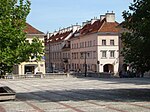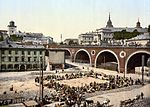Monument to the Mayors of Great Warsaw
2021 establishments in Poland2021 sculpturesBuildings and structures completed in 2021Monuments and memorials in WarsawOutdoor sculptures in Warsaw ... and 4 more
Sculptures of men in PolandSolec, WarsawStatues in PolandStatues of politicians

The Monument to the Mayors of Great Warsaw (Polish: Pomnik Prezydentów Wielkiej Warszawy) is a monument in Warsaw, Poland, located in neighbourhood of Solec in the Downtown district. It is placed at Wybrzeże Gdańskie Street near the intersection with Grodzka Street, next to the gardens of the Royal Castle. It is consists of statues of Stefan Starzyński and Julian Kulski, mayors of Warsaw who served, respectively, from 1934 to 1939, and from 1939 to 1944. The monument was designed by Paweł Pietrusiński, and unveiled on 9 Ocotber 2021.
Excerpt from the Wikipedia article Monument to the Mayors of Great Warsaw (License: CC BY-SA 3.0, Authors, Images).Monument to the Mayors of Great Warsaw
Wybrzeże Gdańskie, Warsaw Midtown
Geographical coordinates (GPS) Address External links Nearby Places Show on map
Geographical coordinates (GPS)
| Latitude | Longitude |
|---|---|
| N 52.249583 ° | E 21.016832 ° |
Address
Julian Kulski i Stefan Starzyński
Wybrzeże Gdańskie
00-301 Warsaw, Midtown
Masovian Voivodeship, Poland
Open on Google Maps










